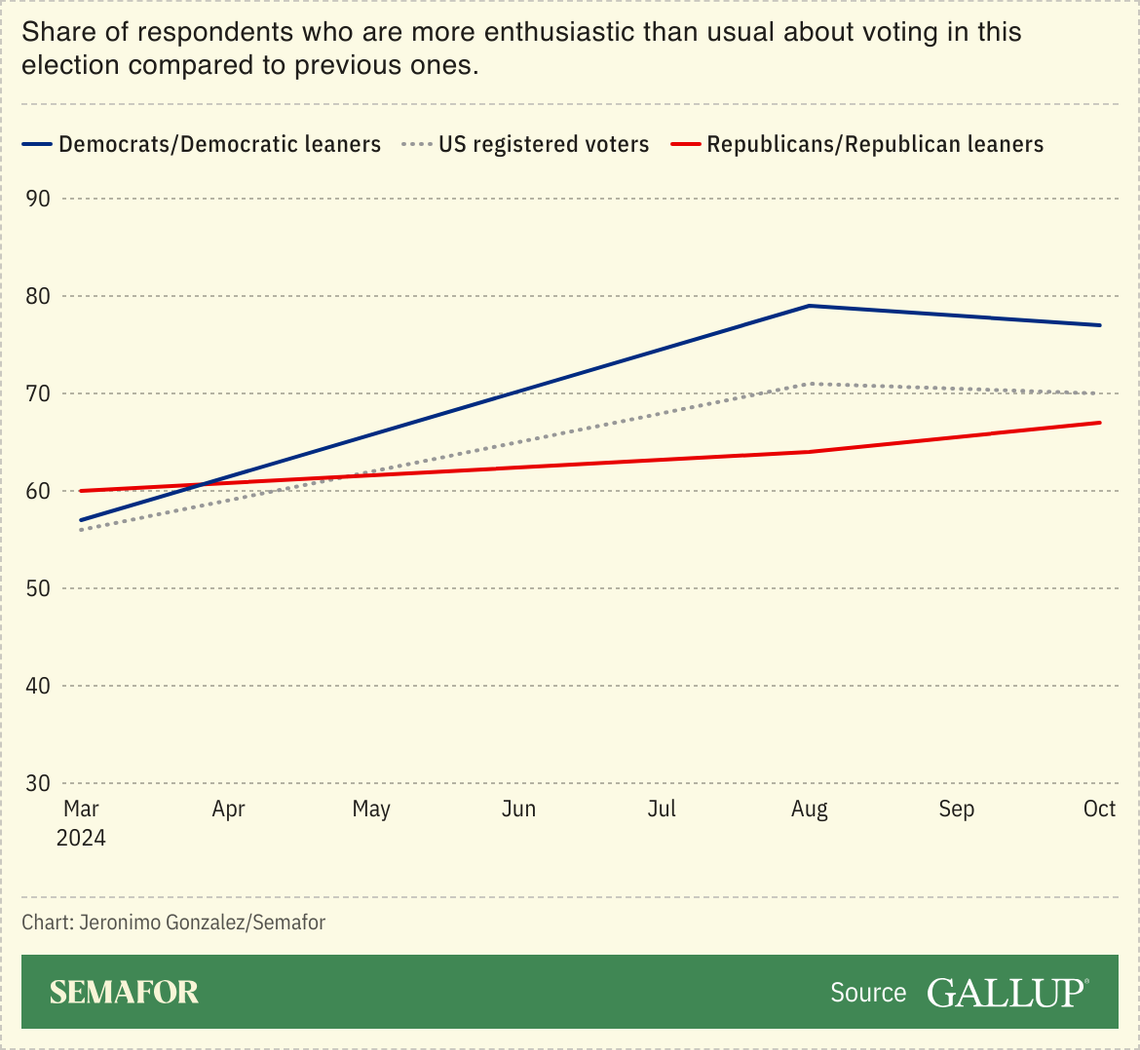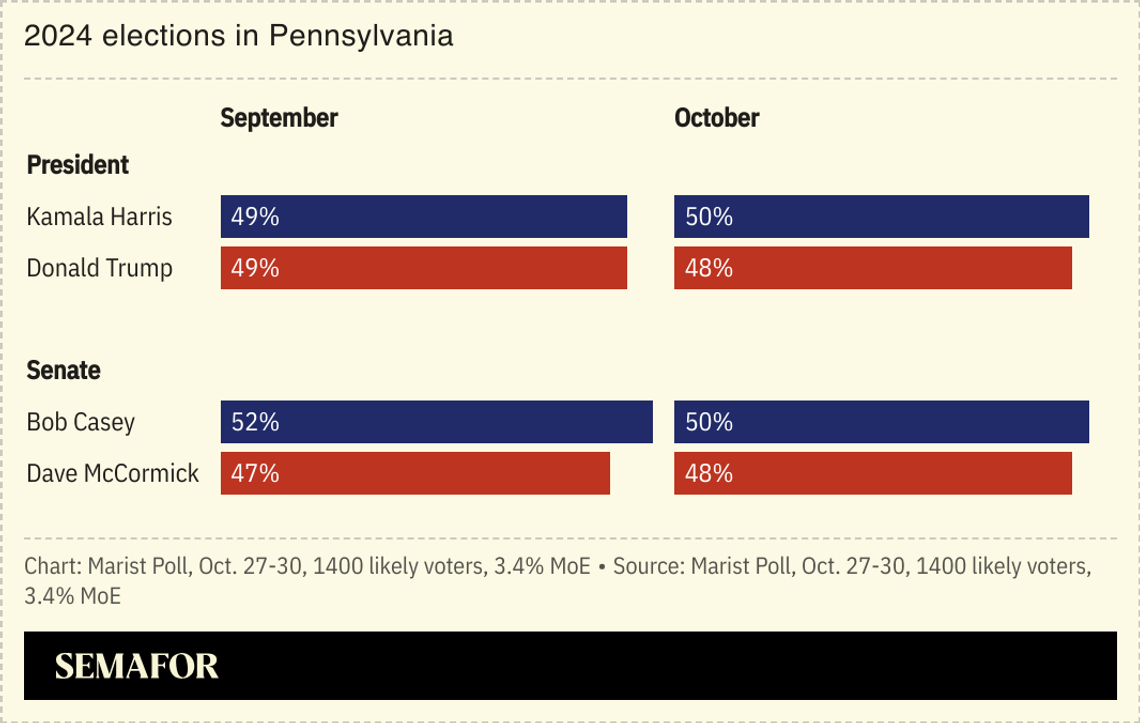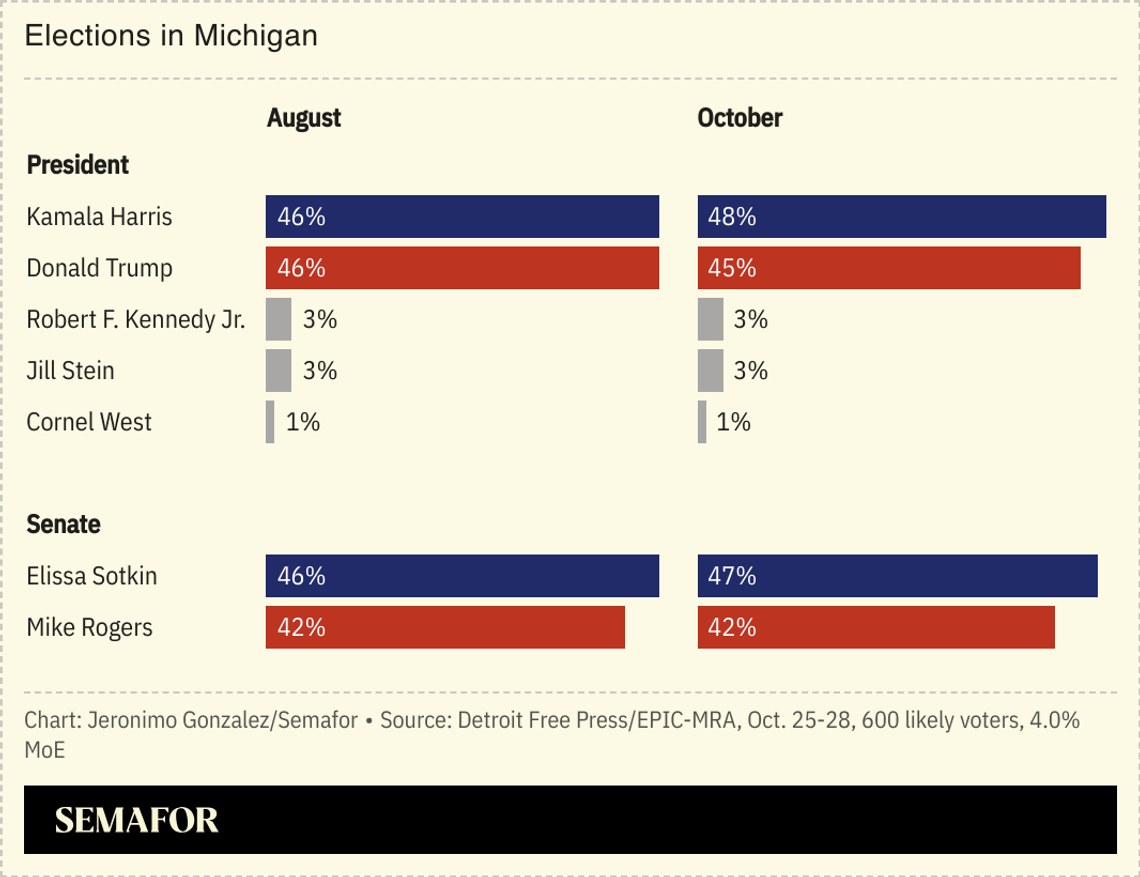 Polls Early voting last month had good news for both Harris and Trump. Both parties saw signs they were turning out voters who didn’t participate (or weren’t 18 yet) in 2020. Republicans had succeeded in convincing some of their reliable Election Day voters to show up early, or send in mail ballots, instead. There’s no evidence in Gallup’s latest polling of a fall-off in turnout for either party — something the Trump campaign has tried to claim for Harris, insisting that the “joy” is gone from her campaign and she struggles to build real crowds. Democrats now have their biggest enthusiasm advantage since 2008, and both parties’ voters feel better about their options than they have since 2012. The caveat for Democrats: That year, Republicans had a nine-point “enthusiasm gap” edge that did nothing for Mitt Romney.  The final wave of established swing state polls, everywhere, show statistical dead heats. There have been outliers — like a respected conservative pollster finding Trump with the biggest GOP lead in Pennsylvania since 1988, carrying the state even if Harris had picked Gov. Josh Shapiro as her running mate. But the overall story has been tied statewide races, with hundreds of millions of dollars in PAC spending cutting away at the gap between Trump and GOP Senate nominees. The other story is Harris using her own policy-focused ads to chip away at Trump’s longtime advantage on which candidate could handle “the economy.” Trump has just a 2-point lead on that question now.  EPIC-MRA is one of the last “benchmark” pollsters, a state-based shop that, with a couple of exceptions, has a record of getting the general election right. One of those exceptions came in 2016, when its final polling found a 4-point Michigan lead for Hillary Clinton. After Trump won the state, pollster Bernie Porn told me that two problems emerged — they had left the field before the impact of the last-minute FBI probe of Clinton, and undecided or third party voters broke for Trump. (Clinton was at just 42% in that final poll, with a huge share of unhappy voters available for Trump to win.) The third party vote is smaller now, and Trump could still benefit from their second choices, because Kennedy has waged a high-profile, failed effort to pull himself off the ballot. But the rest of the data here shows how Harris could win the state, by regaining 2020-level support with Black voters, which would help mitigate any losses by Arab-American voters protesting the administration’s Gaza position. Ads - Osborn for Senate, “Swamp Creature.” For eight years, every Republican who called on Donald Trump to end his campaign over the “Access Hollywood” tape has been attacked for it in Republican ads. This spot for independent Nebraska Senate challenger Dan Osborn is a rarity — it attacks Sen. Deb Fischer for abandoning Trump, from the right, for a candidate largely running to her left. “Deb Fischer has more in common with Hillary Clinton than Donald Trump,” says one actor; another says she “stabbed Donald Trump in the back.”
- Senate Leadership Fund, “Too.” The last-minute GOP super PAC ad buy in Nevada needles Sen. Jacky Rosen over the same votes that have inspired GOP ads in every state. They include: The American Rescue Plan (“inflationary spending”), the Equality Act (“biological men in girls’ sports and bathrooms”) and immigration reform (“amnesty for 11 million illegals”). The through line is that Rosen opposes Trump, an attempt to close the gap between Senate nominee Sam Brown and the presidential candidate.
- Patriots for Perry, “Ex.” To fend off Democrat Janelle Stelson, Pennsylvania Rep. Scott Perry makes three charges: She doesn’t live in the district, she used to be a reporter, and she made a “racist” comment on live TV. The ad never mentions what the comment was — a joke about cat bars in Asia serving “cat tacos.” Republicans now believe that Trump benefited from endorsing a conspiracy theory about Haitian migrants stealing pets to eat them, and Perry notably does not repeat what Stelson actually said, another example of the two-step candidates are doing about what sort of comments are and are not offensive.
Scooped!Inside details on the Harris campaign, gossip from newsroom floors, scandals that no media outlet had confirmed — all framed as “breaking” news. Any X user who reads political news has seen these sorts of posts, from anonymous (but cash verified) accounts that never back up their claims, but get into the conversation anyway. I’d been wondering what the deal with these accounts was, and Sam Stein answers some of my questions in The Bulwark. The fake stories are getting monster traffic. Next - four days until the 2024 presidential election
- 46 days until the Electoral College votes
- 80 days until Inauguration Day
David RecommendsThe novelty of a former president running in his third consecutive election has led to some voter confusion about what Donald Trump would do in power — some to his advantage, some not. It’s helped Trump that voters largely associate him with the pre-COVID economy and haven’t scrutinized how he’d drive prices down. It’s hurt that conservatives at the Heritage Foundation, the Center for Renewing America, and other think tanks announced big plans for a second term that Trump occasionally rebuked. (By the campaign’s final week, he was denying that he ever even wanted to repeal the Affordable Care Act, which was his first major legislative priority as president.) Josh Gerstein’s reporting on who might staff a Trump II administration fills in a lot of gaps, and Sahil Kapur’s reporting on Republicans’ agonized Obamacare conversation highlights an issue that should have been part of the election mix all along. |